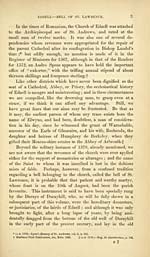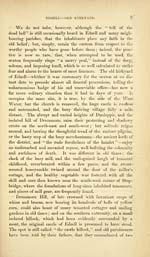Download files
Complete book:
Individual page:
Thumbnail gallery: Grid view | List view

4 LAND OF THE LINDSAfS.
church down to the period of its demolition, it has since been
completely lost sight of.
The loss of this, which was, perhaps, the oldest parochial
relic, is much to be regretted, since all description proves it to
have been an instrument of the most primitive manufacture,
and might suggest a comparison with some of those described
and figured in Dr. Wilson's admirable work on the " Prehistoric
Annals of Scotland."* It was made of common sheet iron, of a
quadrangular form, about a foot high, and correspondingly- wide,
and narrowing a little towards the top. The handle was placed
horizontally on the side, and passing through the bell, formed
the axle of the clapper, which was suspended by an S> The
clapper was of wrought iron, shaped somewhat like a purring
iron, and is said to have been newer than the bell ; but no
person remembers to have seen any trace of writing upon it.
Bells were used by the first christian settlers, and were ever
objects of great veneration, and as duly consecrated as the church
and pastor. St. Columbkill had one on the famous island of Ioua
(commonly, but erroneously, written Iona) ; and St. Teman had
one presented to him by Pope Gregory the Great, which was
deposited beside his relics, and held in high veneration at the
kirk of Banchory Ternan, where he was buried. Prior to the
fashion of administering oaths over the Holy Bible, bells were
used instead ; and instances are on record of people holding
them as evidences of right and title to landed property. This
was the case with the bell of St. Meddan of Airlie. It was
resigned by its hereditary possessor, the Curate, to Sir John
Ogilvy, who gifted it to his lady, in virtue of which she had
possession of a house and toft near the kirk of Luntrathen, and
had her infeftment completed, by being shut up in a house, and
receiving the feudal symbols of earth and stone.f They were
also believed to work many miracles, and, amongst others, to
frighten away the devil from the souls of departed christians, —
hence the origin of the " warning of the passing bell " at
funerals — a practice which, though one of the oldest and most
revered rites of the Roman Church, is yet used in some presby-
terian districts, and dealt out on the same pecuniary considera-
tions as it was by our superstitious forefathers.
* Erfin,, 1391, p. G52, et sub. 1 (k.t>. U47)-Spalding Club Miscel., vol. iv., pp. 117, 118.
church down to the period of its demolition, it has since been
completely lost sight of.
The loss of this, which was, perhaps, the oldest parochial
relic, is much to be regretted, since all description proves it to
have been an instrument of the most primitive manufacture,
and might suggest a comparison with some of those described
and figured in Dr. Wilson's admirable work on the " Prehistoric
Annals of Scotland."* It was made of common sheet iron, of a
quadrangular form, about a foot high, and correspondingly- wide,
and narrowing a little towards the top. The handle was placed
horizontally on the side, and passing through the bell, formed
the axle of the clapper, which was suspended by an S> The
clapper was of wrought iron, shaped somewhat like a purring
iron, and is said to have been newer than the bell ; but no
person remembers to have seen any trace of writing upon it.
Bells were used by the first christian settlers, and were ever
objects of great veneration, and as duly consecrated as the church
and pastor. St. Columbkill had one on the famous island of Ioua
(commonly, but erroneously, written Iona) ; and St. Teman had
one presented to him by Pope Gregory the Great, which was
deposited beside his relics, and held in high veneration at the
kirk of Banchory Ternan, where he was buried. Prior to the
fashion of administering oaths over the Holy Bible, bells were
used instead ; and instances are on record of people holding
them as evidences of right and title to landed property. This
was the case with the bell of St. Meddan of Airlie. It was
resigned by its hereditary possessor, the Curate, to Sir John
Ogilvy, who gifted it to his lady, in virtue of which she had
possession of a house and toft near the kirk of Luntrathen, and
had her infeftment completed, by being shut up in a house, and
receiving the feudal symbols of earth and stone.f They were
also believed to work many miracles, and, amongst others, to
frighten away the devil from the souls of departed christians, —
hence the origin of the " warning of the passing bell " at
funerals — a practice which, though one of the oldest and most
revered rites of the Roman Church, is yet used in some presby-
terian districts, and dealt out on the same pecuniary considera-
tions as it was by our superstitious forefathers.
* Erfin,, 1391, p. G52, et sub. 1 (k.t>. U47)-Spalding Club Miscel., vol. iv., pp. 117, 118.
Set display mode to:
![]() Universal Viewer |
Universal Viewer | ![]() Mirador |
Large image | Transcription
Mirador |
Large image | Transcription
Images and transcriptions on this page, including medium image downloads, may be used under the Creative Commons Attribution 4.0 International Licence unless otherwise stated. ![]()
| Histories of Scottish families > History and traditions of the land of the Lindsays in Angus and Mearns > (22) Page 4 |
|---|
| Permanent URL | https://digital.nls.uk/94869290 |
|---|
| Description | A selection of almost 400 printed items relating to the history of Scottish families, mostly dating from the 19th and early 20th centuries. Includes memoirs, genealogies and clan histories, with a few produced by emigrant families. The earliest family history goes back to AD 916. |
|---|

